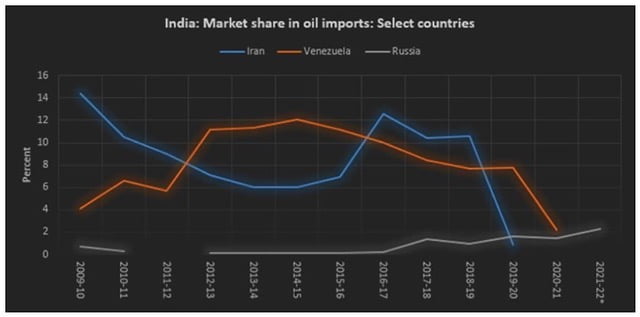UPSC Articles
(ORF: Expert Speak)
April 2: India’s oil imports: Trends in diversification – https://www.orfonline.org/expert-speak/indias-oil-imports/
TOPIC:
- GS-3: Indian economy
- GS-3: Energy
India’s oil imports: Trends in diversification
Context: In the pandemic year 2020-21, over 84 percent of India’s petroleum product demand (crude oil and petroleum products) was met with imports.
- Gross petroleum imports of about 239 million tonnes (MT) of value US$77 billion accounted for over 19 percent of India’s total imports in 2020-21.
- In 2019-20, over 85 percent of petroleum product demand was met with imports.
- Gross petroleum imports of over 270 MT of value US$119 billion accounted for 25 percent of India’s total imports. This is a substantial increase compared to 2006-07, when oil imports of about 145 MT accounted for about 77 percent of consumption.
India’s Energy Security
In the early 2000s, the growing volume of crude oil imports was seen to be associated with two key external risks for India’s energy security –
- The first was the volume risk, which originated from the fact that most of the global conventional oil reserves and most of India’s oil imports were concentrated in the Persian Gulf. It was assumed that the political and social volatility in the Persian Gulf region increased the possibility of deliberate oil supply disruptions by state or non-state actors.
- The second was the price risk, which was the probability of a dramatic increase in the price of oil in the international market on account of, amongst other things
- Instability in oil producing regions
- Reduction in supply on account of policies adopted in producing countries
- International sanctions against oil procurement from specific countries.
India’s Take: Volume risk in oil supply was prioritised over the price risk and addressed with strategies such as
- Diversification of oil import basket
- Acquisition of equity oil assets around the world
Recent trends in India’s crude import basket
The top oil exporter to India in 2020-21 was Iraq followed by Saudi Arabia.
- Iraq’s share in India’s imports increased from about 9% in 2009-10 to over 22% in 2020-21.
- Though Saudi Arabia lost its long-held position as the largest source of India’s oil imports to Iraq in 2017-18, Saudi Arabia’s share has remained steady between 17-18% of India’s imports over a decade.
- Interestingly, the USA that was not among the top 20 oil exporters to India a decade ago, it was the 18th largest exporter in 2017-18, ninth largest in 2018-19, seventh largest in 2019-20, and fourth largest in 2020-21.
- Apart from the fact that crude oil exports from the USA were illegal until 2015, USA was also a large net importer of crude oil.
- With the growth in production of shale oil, the USA is now not only a net exporter of crude oil but also the world’s largest producer.
- The entry of the USA as India’s 4th largest source of oil imports breaks the trend of Saudi Arabia, Iraq, Iran, Kuwait, the UAE, Nigeria, and Venezuela dominating India’s top five oil import sources for over two decades.
- Russia, the country to come under Western sanctions in 2022, is not a large source of India’s oil imports but it has remained in India’s long portfolio of oil importers for over a decade. In 2021-22 (April to January), Russia’s share in India’s oil importers was 2.3%, which put Russia among India’s top 10 sources of oil imports.
The Call for Diversification – Supply insecurity
- Supply disruptions in the Persian Gulf was a high-impact event to which high-probability was attached and diversification of supply sources was seen as the rational response, given that countries in the region account for over 60% of India’s oil imports.
- Though oil supply disruptions in the Persian Gulf is a high-impact event even today, the probability of occurrence is not as high as it was assumed to be in the era of the war against terrorism.
- More importantly ‘demand insecurity’ and the consequent competition amongst oil exporters to gain market share in India, one of the few large growth markets for oil around the world, is influencing diversification more than supply-insecurity.

Source: Ministry of Commerce & Industry; * 2021-22 (April 2021 to January 2022)
Conclusion
- The competition for oil markets has been introduced for the first time in several decades, oil exporters from the western hemisphere notably the USA and Russia, amongst the top 10 oil exporters to India.
- Geopolitical sanctions may introduce minor short-term aberrations in India’s oil import basket, but this cannot alter longer-term economic trends.
Can you answer the following question?
- India needs to carefully devise strategies to diversify its oil import sources. Discuss.













